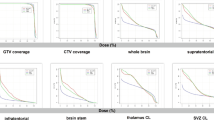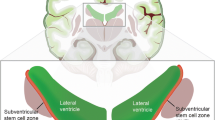Abstract
Radiation therapy (RT) for brain tumors is associated with neurocognitive toxicity which may be a result of damage to neural progenitor cells (NPCs). We present a novel technique to limit the radiation dose to NPC without compromising tumor coverage. A study was performed in mice to examine the rationale and another was conducted in humans to determine its feasibility. C57BL/6 mice received localized radiation using a dedicated animal irradiation system with on-board CT imaging with either: (1) Radiation which spared NPC containing regions; (2) Radiation which did not spare these niches; or (3) Sham irradiation. Mice were sacrificed 24 h later and the brains were processed for immunohistochemical Ki-67 staining. For the human component of the study, 33 patients with primary brain tumors were evaluated. Two intensity modulated radiotherapy (IMRT) plans were retrospectively compared: a standard clinical plan and a plan which spares NPC regions while maintaining the same dose coverage of the tumor. The change in radiation dose to the contralateral NPC-containing regions was recorded. In the mouse model, non-NPC-sparing radiation treatment resulted in a significant decrease in the number of Ki67+ cells in dentate gyrus (DG) (P = 0.008) and subventricular zone (SVZ) (P = 0.005) compared to NPC-sparing radiation treatment. In NPC-sparing clinical plans, NPC regions received significantly lower radiation dose with no clinically relevant changes in tumor coverage. This novel radiation technique should significantly reduce radiation doses to NPC containing regions of the brain which may reduce neurocognitive deficits following RT for brain tumors.




Similar content being viewed by others
References
Johannesen TB, Lien HH, Hole KH, Lote K (2003) Radiological and clinical assessment of long-term brain tumour survivors after radiotherapy. Radiother Oncol 69(suppl. 2):169–176
Silber JH, Radcliffe J, Peckham V et al (1992) Whole-brain irradiation and decline in intelligence: the influence of dose and age on IQ score. J Clin Oncol 10(suppl. 9):1390–1396
Ris MD, Packer R, Goldwein J, Jones-Wallace D, Boyett JM (2001) Intellectual outcome after reduced-dose radiation therapy plus adjuvant chemotherapy for medulloblastoma: a children’s cancer group study. J Clin Oncol 19(suppl. 15):3470–3476
Hoppe-Hirsch E, Brunet L, Laroussinie F et al (1995) Intellectual outcome in children with malignant tumors of the posterior fossa: influence of the field of irradiation and quality of surgery. Childs Nerv Syst 11(suppl. 6):340–346
Schatz J, Kramer JH, Ablin A, Matthay KK (2000) Processing speed, working memory, and IQ: a developmental model of cognitive deficits following cranial radiation therapy. Neuropsychology 14(suppl. 2):189–200
Penitzka S, Steinvorth S, Sehlleier S, Fuß M, Wannenmacher M, Wenz F (2002) Assessment of cognitive functions after prophylactic and therapeutic whole brain irradiation using neuropsychological testing. Strahlenther Onkol 178(suppl. 5):252–258
Tada E, Parent JM, Lowenstein DH, Fike JR (2000) X-irradiation causes a prolonged reduction in cell proliferation in the dentate gyrus of adult rats. Neuroscience 99(suppl. 1):33–41
Mizumatsu S, Monje ML, Morhardt DR, Rola R, Palmer TD, Fike JR (2003) Extreme sensitivity of adult neurogenesis to low doses of X-irradiation. Cancer Res 63(suppl. 14):4021–4027
Monje ML, Toda H, Palmer TD (2003) Inflammatory blockade restores adult hippocampal neurogenesis. Science 302(suppl. 5651):1760–1765
Madsen TM, Kristjansen PEG, Bolwig TG, Wörtwein G (2003) Arrested neuronal proliferation and impaired hippocampal function following fractionated brain irradiation in the adult rat. Neuroscience 119(suppl. 3):635–642
Rola R, Raber J, Rizk A et al (2004) Radiation-induced impairment of hippocampal neurogenesis is associated with cognitive deficits in young mice. Exp Neurol 188(suppl. 2):316–330
Saxe MD, Battaglia F, Wang J et al (2006) Ablation of hippocampal neurogenesis impairs contextual fear conditioning and synaptic plasticity in the dentate gyrus. Proc Natl Acad Sci USA 103(suppl. 46):17501–17506
Winocur G, Wojtowicz JM, Sekeres M, Snyder JS, Wang S (2006) Inhibition of neurogenesis interferes with hippocampus-dependent memory function. Hippocampus 16(suppl. 3):296–304
Gage FH (2000) Mammalian neural stem cells. Science 287(suppl. 5457):1433–1438
Quinones-Hinojosa A, Sanai N, Soriano-Navarro M et al (2006) Cellular composition and cytoarchitecture of the adult human subventricular zone: a niche of neural stem cells. J Comp Neurol 494(suppl. 3):415–434
Sanai N, Tramontin AD, Quinones-Hinojosa A et al (2004) Unique astrocyte ribbon in adult human brain contains neural stem cells but lacks chain migration. Nature 427(suppl. 6976):740–744
Arvidsson A, Collin T, Kirik D, Kokaia Z, Lindvall O (2002) Neuronal replacement from endogenous precursors in the adult brain after stroke. Nat Med 8(suppl. 9):963–970
Goings GE, Sahni V, Szele FG (2004) Migration patterns of subventricular zone cells in adult mice change after cerebral cortex injury. Brain Res 996(suppl. 2):213–226
François S, Bensidhoum M, Mouiseddine M et al (2006) Local irradiation not only induces homing of human mesenchymal stem cells at exposed sites but promotes their widespread engraftment to multiple organs: a study of their quantitative distribution after irradiation damage. Stem Cells 24(suppl. 4):1020–1029
Mouiseddine M, François S, Semont A et al (2007) Human mesenchymal stem cells home specifically to radiation-injured tissues in a non-obese diabetes/severe combined immunodeficiency mouse model. Br J Radiol 80(suppl. SPEC. ISS. 1):S49–S55
Fike JR, Rola R, Limoli CL (2007) Radiation response of neural precursor cells. Neurosurg Clin N Am 18(suppl. 1):115–127
Panagiotakos G, Alshamy G, Chan B et al (2007) Long-term impact of radiation on the stem cell and oligodendrocyte precursors in the brain. PLoS ONE 2(suppl. 7):e588
Hopewell JW, Cavanagh JB (1972) Effects of X irradiation on the mitotic activity of the subependymal plate of rats. Br J Radiol 45(suppl. 534):461–465
Iuvone L, Mariotti P, Colosimo C, Guzzetta F, Ruggiero A, Riccardi R (2002) Long-term cognitive outcome, brain computed tomography scan, and magnetic resonance imaging in children cured for acute lymphoblastic leukemia. Cancer 95(suppl. 12):2562–2570
Lesnik PG, Ciesielski KT, Hart BL, Benzel EC, Sanders JA (1998) Evidence for cerebellar-frontal subsystem changes in children treated with intrathecal chemotherapy for leukemia: enhanced data analysis using an effect size model. Arch Neurol 55(suppl. 12):1561–1568
Waber DP, Tarbell NJ, Kahn CM, Gelber RD, Sallan SE (1992) The relationship of sex and treatment modality to neuropsychologic outcome in childhood acute lymphoblastic leukemia. J Clin Oncol 10(suppl. 5):810–817
Bakke SJ, Fossen A, Storm-Mathiesen I, Lie SO (1993) Long-term cerebral effects of CNS chemotherapy in children with acute lymphoblastic leukemia. Pediatr Hematol Oncol 10(suppl. 3):267–270
Grossman SA, Reinhard CS, Loats HL (1989) The intracerebral penetration of intraventricularly administered methotrexate: a quantitative autoradiographic study. J Neurooncol 7(suppl. 4):319–328
Ghia A, Tomé WA, Thomas S et al (2007) Distribution of brain metastases in relation to the hippocampus: implications for neurocognitive functional preservation. Int J Radiat Oncol Biol Phys 68(suppl. 4):971–977
Gutiérrez AN, Westerly DC, Tomé WA et al (2007) Whole brain radiotherapy with hippocampal avoidance and simultaneously integrated brain metastases boost: a planning study. Int J Radiat Oncol Biol Phys 69(suppl. 2):589–597
Barani IJ, Cuttino LW, Benedict SH et al (2007) Neural stem cell-preserving external-beam radiotherapy of central nervous system malignancies. Int J Radiat Oncol Biol Phys 68(suppl. 4):978–985
Gondi V, Tollakanahalli R, Mehta M et al (2010) Hippocampal-sparing whole brain radiotherapy: a “how-to” technique using helical tomotherapy and linear accelerated based intensity-modulated radiotherapy. Int J Radiat Oncol Biol Phys 78(4):1244–1252
Wong J, Armour E, Kazanzides P et al (2008) High-resolution, small animal radiation research platform with X-ray tomographic guidance capabilities. Int J Radiat Oncol Biol Phys 71(suppl. 5):1591–1599
Tryggestad E, Armour M, Iordachita I, Verhaegen F, Wong JW (2009) A comprehensive system for dosimetric commissioning and Monte Carlo validation for the small animal radiation research platform. Phys Med Biol 54(suppl. 17):5341–5357
Rogers DWO, Faddegon BA, Ding GX, Ma C, We J, Mackie TR (1995) BEAM: a Monte Carlo code to simulate radiotherapy treatment units. Med Phys 22(suppl. 5):503–524
Kee N, Sivalingam S, Boonstra R, Wojtowicz JM (2002) The utility of Ki-67 and BrdU as proliferative markers of adult neurogenesis. J Neurosci Methods 115(suppl. 1):97–105
Acknowledgments
Grant support: Alfredo Quinones-Hinojosa, MD NIH/NINDS K08, HHMI, The Robert Wood Johnson Foundation/Harold Amos Medical Faculty Development Program, Maryland Stem Cell Technology Development Corporation (TEDCO), Children Cancer Foundation (CCF).
Conflicts of interest
Eric Ford, PhD and Erik Tryggestad, PhD are partially supported under a licensing agreement between the Johns Hopkins University and Gulmay Medical Ltd. for commercialization of the radiation devices discussed in this manuscript.
Author information
Authors and Affiliations
Corresponding author
Rights and permissions
About this article
Cite this article
Redmond, K.J., Achanta, P., Grossman, S.A. et al. A radiotherapy technique to limit dose to neural progenitor cell niches without compromising tumor coverage. J Neurooncol 104, 579–587 (2011). https://doi.org/10.1007/s11060-011-0530-8
Received:
Accepted:
Published:
Issue Date:
DOI: https://doi.org/10.1007/s11060-011-0530-8




